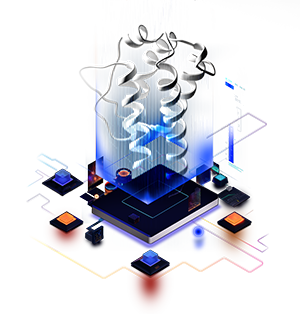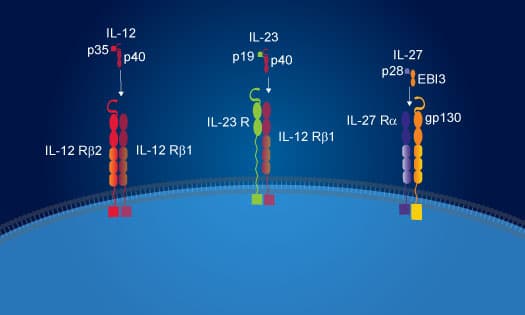Cytokines are typically small (5-20 kDa), signaling proteins secreted by cells that act as intercellular messengers to regulate a diverse array of biological processes. Interleukins, interferons, adipokines, chemokines, and members of the tumor necrosis superfamily are all considered to be cytokines. These proteins are produced by a variety of different cell types, including one or more of the following: adipocytes, endothelial cells, epithelial cells, fibroblasts, stromal cells, and immune cells such as T cells, B cells, innate lymphoid cells, dendritic cells, and macrophages.
Cytokines function by binding to specific cell surface receptors that promote the activation of intracellular signaling pathways, which induce responses such as proliferation, differentiation, activation, migration, effector activity, or cell death. As a result, cytokines affect nearly every biological process from embryonic development, immune responses, and wound healing, to tissue remodeling, disease pathogenesis, and aging. Cytokines play a particularly prominent role in regulating immunity and inflammatory responses following infection. They typically function to protect the host against invading pathogens by serving as cellular communication signals to amplify immune responses, but they can also have harmful effects under conditions where they are overproduced. This results in elevated circulating cytokine levels and can lead to immune cell hyperactivation characteristic of systemic inflammatory syndromes such as cytokine release syndrome or cytokine storm. Changes in the levels of specific cytokines are also associated with chronic inflammation in pathological conditions such as cancer, metabolic syndrome, diabetes, neuroinflammatory disorders, and autoimmune diseases.
Cytokines can mediate autocrine, paracrine, and endocrine signaling. Local cytokine signaling occurs through autocrine and paracrine signaling, which takes place when a cytokine secreted by a specific cell binds to its receptor on the same cell or on neighboring cells, respectively. Endocrine signaling by cytokines is thought to be less common but occurs when these molecules travel through the blood and have an effect on cells or tissues that are more distant from the cytokine-producing cell. In addition to receptors on the cell surface, many cytokines can also bind to soluble cytokine receptors, which can act as either agonists or antagonists of cytokine signaling. Since many cytokines are pleiotropic, they can have multiple different effects on different cell types.
Featured Cytokine Products
Proteins for Immune Cell Culture
Proteins for Immune Cell Culture
Achieve robust, reproducible immune cell cultures with R&D Systems™ proteins. Our proteins are rigorously tested to ensure they will provide superior performance and lot-to-lot consistency, so you can have confidence in their ability to promote optimal immune cell expansion with minimal variability between cultures.
ELISA Kits for Soluble Cytokine Analysis
ELISA Kits for Soluble Cytokine Analysis
Analyze the cytokine secretion profiles of different cell types and have confidence in your results with our rigorously validated ELISA Kits. From our complete, ready-to-use Quantikine™ ELISA Kits and our 90-minute QuicKit ELISAs to our more versatile DuoSet™ ELISA Development Systems, you can count on our immunoassays to deliver accurate, reproducible data every time.
Conjugated Antibodies for Cytokine Analysis by Flow Cytometry
Conjugated Antibodies for Cytokine Analysis by Flow Cytometry
Detect intracellular cytokines using our fluorescent-labeled antibodies for flow cytometry. Our extensive range of flow cytometry-validated antibodies against common and unique targets, coupled with our selection of 28 fluorescent labels, makes it easy to find the antibody-fluorochrome combinations you need and provides flexibility for multicolor panel design.
Cytokine Products by Application
Customer Success Stories
Cytokine Products by Family

Adipokines
Adipokines
• Investigate the effects of proteins secreted by the adipose tissue, including leptin, adiponectin, chemerin, omentin, resistin, visfatin, and adipsin, among others

Chemokines
Chemokines
• Learn about members of the C, CC, CXC, and CX3C chemokine subfamilies and their functions during development, homeostasis, and inflammation

Common Receptor Beta Chain Family
Common Receptor Beta Chain Family
• View products for proteins belonging to the common beta chain family, including GM-CSF, IL-3, and IL-5

Common Receptor Gamma Chain Family
Common Receptor Gamma Chain Family
• Explore the unique and overlapping effects of IL-2, IL-4, IL-7, IL-9, IL-15, and IL-21 on the development and functions of different immune cell types

IL-1 Family Cytokines
IL-1 Family Cytokines
• Learn about members of the IL-1 cytokine family, including IL-1 alpha and beta, IL-1ra, IL-18, IL-33, IL-36 alpha, beta, and gamma, IL-36Ra, IL-37, and IL-38

IL-6 Family Cytokines
IL-6 Family Cytokines
• Explore the distinct and overlapping functions of members of the IL-6 cytokine family, including IL-6, IL-11, IL-27p28, IL-31, LIF, OSM, CLC, CNTF, CT-1, and neuropoietin

IL-10 Family Cytokines
IL-10 Family Cytokines
• Investigate the signaling pathways and the biological effects of the IL-10 family cytokines, including IL-10, IL-19, IL-20, IL-22, IL-24, and IL-26
IL-12 Family Cytokines
IL-12 Family Cytokines
• Learn about the heterodimeric cytokines belonging to the IL-12 family, including IL-12, IL-23, IL-27, IL-35, and IL-39

IL-17 Family Cytokines
IL-17 Family Cytokines
• Learn about the pro-inflammatory effects of the IL-17 cytokine family, which includes IL-17A, IL-17B, IL-17C, IL-17D, IL-17E/IL-25, and IL-17F

Interferons
Interferons
• Learn about the anti-viral and immunoregulatory effects of the type I, type II, and type III interferons

M-CSF, SCF, Flt-3 L
M-CSF, SCF, Flt-3 L
• Browse products for M-CSF, SCF, and Flt-3 Ligand, three short-chain, four-helix bundle cytokines that bind to class III receptor tyrosine kinases

TNF Superfamily
TNF Superfamily
• Explore how the TNFSF ligands and their receptors are involved in regulating immune cell activities, inflammation, and apoptosis
Cytokine Related Resources
Background Information on Cytokines
Cytokines are grouped into large families based on structural similarities and the specificities and composition of their receptor complexes. These families include the four helix bundle cytokines, beta-trefoil cytokines that signal through immunoglobulin superfamily receptors, cysteine-knot cytokines, chemokines, and the TNF superfamily cytokines. The four-helix bundle cytokines are further subdivided into ligands for the class I and class II cytokine receptor families. The ligands for the class I cytokine receptors share a four alpha-helical bundle structure that is arranged in an up-up-down-down topology and are subdivided into short-chain and long-chain cytokines. Short-chain cytokines include the common beta-chain and common gamma-chain family cytokines, IL-13, and TSLP. M-CSF, IL-34, Flt-3 Ligand, and SCF are also short-chain four helix bundle cytokines, but these cytokines signal through class III receptor tyrosine kinases. Long-chain cytokines of the class I cytokine receptor family include the IL-6 family cytokines, G-CSF, erythropoietin, thrombopoietin, growth hormone, prolactin, and leptin. Ligands for the class II cytokine receptor family consist of the IL-10 family cytokines, along with the type I, type II, and type III interferons. These cytokines have a common structure with six alpha-helices and are expressed as monomers or homodimers. IL-1 family cytokines are classified as beta-trefoil superfamily cytokines that signal through immunoglobulin superfamily receptors, while the IL-17 family cytokines belong to the cysteine-knot superfamily and bind to members of the IL-17 receptor family.
Chemokines are divided into four subfamilies: the C, CC, CXC, and CX3C chemokines. The subfamily designation is based on the number and spacing of conserved cysteine residues located in the amino-terminus of the protein. In addition, chemokines are classified as homeostatic, inflammatory, or dual-functioning, based on their functions and expression patterns. All chemokines bind to seven transmembrane G protein-coupled receptors (GPCRs) to activate downstream signaling pathways. The chemokine system is complex in that many chemokine receptors can be activated by more than one chemokine, and many different cell types express more than one chemokine receptor at one time, making it difficult at times to discern the role of one chemokine versus another in a particular context.
Tumor necrosis factor (TNF) superfamily ligands are characterized by a stalk that connects the transmembrane domain to a core region that contains a domain known as the TNF homology domain (THD), the hallmark structure of TNF family ligands. The THD is an anti-parallel beta-pleated sheet sandwich with a “jelly-roll” topology. Receptors for TNF family ligands are oligomeric, type I or type II transmembrane proteins that contain multiple extracellular cysteine-rich domains. Many of the TNF superfamily receptors also contain intracellular death domains, which interact with other death domain-containing proteins to initiate the extrinsic pathway of caspase activation, following ligand binding. Other TNF superfamily proteins regulate cell type-specific responses and immune cell functions, including T cell co-stimulation, natural killer cell activation, and B cell activation.


















